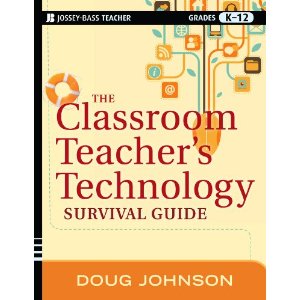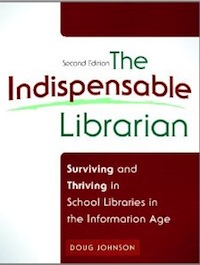Blogging and the School Library Media Specialist
Blogging and the Media Specialist
Media Matters, Leading & Learning, March 2006
Have you noticed that the Web is undergoing a transformation? Are terms like blogs, wikis, podcasts, and RSS feeds now a part of your and your students’ vocabularies? If they aren’t, they should be. These forms of communication and information management are part of what Tim O’Reilly describes as a shift from Web 1.0 to Web 2.0 (1): a movement from the web being a static means of one-way, mass communication to an interactive, personal communication medium.
This “Media Matters” column will focus on a single aspect of the Web 2.0 movement – web logs, or blogs as they are more commonly called. This month I’ll look at the definition of a blog, show you how to find blogs to read and how to keep up with them, and present a short list of library media and technology related professional blogs. In the next column, Frances Jacobson Harris, library media specialist at University Laboratory High School, University of Illinois at Urbana-Champaign, will describe how she and others use blogs as a means of communication in the library media program and will share her observations about how students use blogs.
So what’s a web log (blog)?
A blog in its most generic sense is a website that is updated on a regular basis, displays the content in reverse chronological order (newest entries first), and allows, even invites, reader response. See L&L’s “Mining the Internet” column, September 2003 (2), and “Seven Things You Should Know About Blogs” (3), for good overviews. While text remains the primary means bloggers use to communicate, these sites increasing include text, audio (podcasts) and video clips. Anything found on a web page can be found on a blog. (Will Richardson at Weblogg-ed <www.weblogg-ed.com> makes some interesting observations about using blogs for “connective writing,” pushing the envelope about the definition of a blog.)
A blog requires little, if any, knowledge of html coding. There are many no-cost sites that allow the creation of a blog and its hosting. Popular blog sites, used by both adults and kids, include Blogger <www.blogger.com>, Livejournal and Xanga <www.xanga.com>. Edublogs <edublogs.org> and Blog Meister <epnweb.org/blogmeister/> are specifically designed to support use by educators.
Blogs got their start as personal journals, often with highly political overtones. But increasingly, blogs are replacing e-zines and static websites as a means for organizations to communicate with members and customers on a more formal basis. Some K-12 schools have replaced their regular websites with blogs that are easy for multiple authors to update.
Finding blogs of personal interest
There are two basic ways of locating blogs (among the 20+ million existing!) of interest: using a search engine or finding links to other blogs on blogs themselves.
Three popular specialized blog search tools are Technorati <www.technorati.com>, Google Blog Search <blogsearch.google.com> and Bloglines (see below). In their current forms, I’ve found these tools to be rather inefficient.
Another means of finding blogs of interest is to examine the “the blogs I read” or “blogroll” section that is a common part of many blogs. If you find a particular blog interesting, there is a good chance you will like the blogs the writer of that blog reads.
Keeping up with blogs
It’s easy to find a large number of blogs that have interesting and useful content. But it’s time consuming to bookmark and check each blog on a daily basis for updates, especially when updates to most blogs are made irregularly. An RSS feed aggregator, like Bloglines < www.bloglines.com> can help.
RSS (Rich Site Summary or Really Simple Syndication) is programming code in a webpage that allows readers to “subscribe” to the site, and be alerted when additions have been made.
Most blogs include an RSS feed that aggregators recognize. Bloglines, a simple, free, online RSS aggregator becomes a blog reader’s “one-stop-shop” for organizing blogs and checking for blog updates. After adding the URL for a blog to your “feeds,” a single glance at this single website will show whether a blog has been updated. The new entry can either be read in Bloglines itself, or the reader can click through to the actual blog site itself. A very good tutorial is available (4).
Recommended blogs:
While blogs tend to come and go, some updated more regularly than others, I’ve found the blogs below to have interesting and current content:
School library media
Berger, Pam Infosearcher <www.infosearcher.com/>
Bowllan, Amy School Library Journal Blog < www.schoollibraryjournal.com/blog>
Chen, Diane Deep Thinking <deepthinking.blogsome.com>
Eiffert, Robert Librarian in the Middle <http://www.beiffert.net/wordpress/>
Harris, Chris Infomancy <www.schoolof.info/infomancy>
Johnson, Doug The Blue Skunk Blog <doug-johnson.squarespace.com/blue-skunk-blog>
Schneider, Karen The Free Range Librarian <freerangelibrarian.com>
Valenza, Joyce The Neverending Search <joycevalenza.edublogs.org>
Yucht, Alice Alice in Infoland <aliceinfo.squarespace.com/blog/>
Educational technology
Block, Marylaine Neat New Stuff <http://www.marylaine.com/neatnew.html>
Blackall, Leigh Teach and Learn Online <http://teachandlearnonline.blogspot.com/>
Jukes, Ian The Committed Sardine <homepage.mac.com/iajukes/blogwavestudio>
Lauer, Tim Education/Technology <http://tim.lauer.name/>
Pederson, John Pedersondesigns <pedersondesigns.com>
Richardson, Will Weblogg-ed <www.weblogg-ed.com>
Schrock, Kathy Kaffeeklatsch <kathyschrock.blogspot.com>
Warlick, David 2 Cents Worth <davidwarlick.com/2cents>
Wilson, Tim The Savvy Technologist <technosavvy.org>
For an interesting view of librarian bloggers worldwide, look at the Frapper website <www.frappr.com/blogginglibrarians>. And add yourself if you are a library blogger.
In the role of “information expert,” school library media specialists should know about blogs and use them professionally. They are an increasingly popular source of information and a popular communication tool for students and adults. They can be a powerful tool for media specialists to communicate with staff and students. And they bring with them their own special set of safe, ethical and appropriate use issues.
Thanks to John Pederson’s wiki Web 2.0 Tutorials for Educators <www.pedersondesigns.com/wiki> for several of these resources. Also thanks to Graham Wegner, Donna Baumbach, Josh Thomas, and Sue Tanner for the improvements they made to this article when it was posted as a wiki.
- O’Reilly, “What Is Web 2.0: Design Patterns and Business Models for the Next Generation of Software” O’Reilly Net, September 30, 2005 < http://www.oreillynet.com/pub/a/oreilly/tim/news/2005/09/30/what-is-web-20.html>
- Bull,Bull and Kajder, “Writing with Weblogs.” Leading & Learning, vol. 31 no. 1.
- “Seven Things You Should Know About Blogs.” EDUCAUSE, 2005 <http://www.educause.edu/LibraryDetailPage/666?ID=ELI7006>
- Rai, Preetam “Using Bloglines (or How to keep up with dozens of blogs everyday).” Betterdays blog, April 2005. <http://preetamrai.com/weblog/archives/2005/04/25/bloglines-how-to-keep-track-of-hundreds-of-blogs-and-some-news-and-some-podcasts-and-some-flickrs-photos-etc-etc/>




